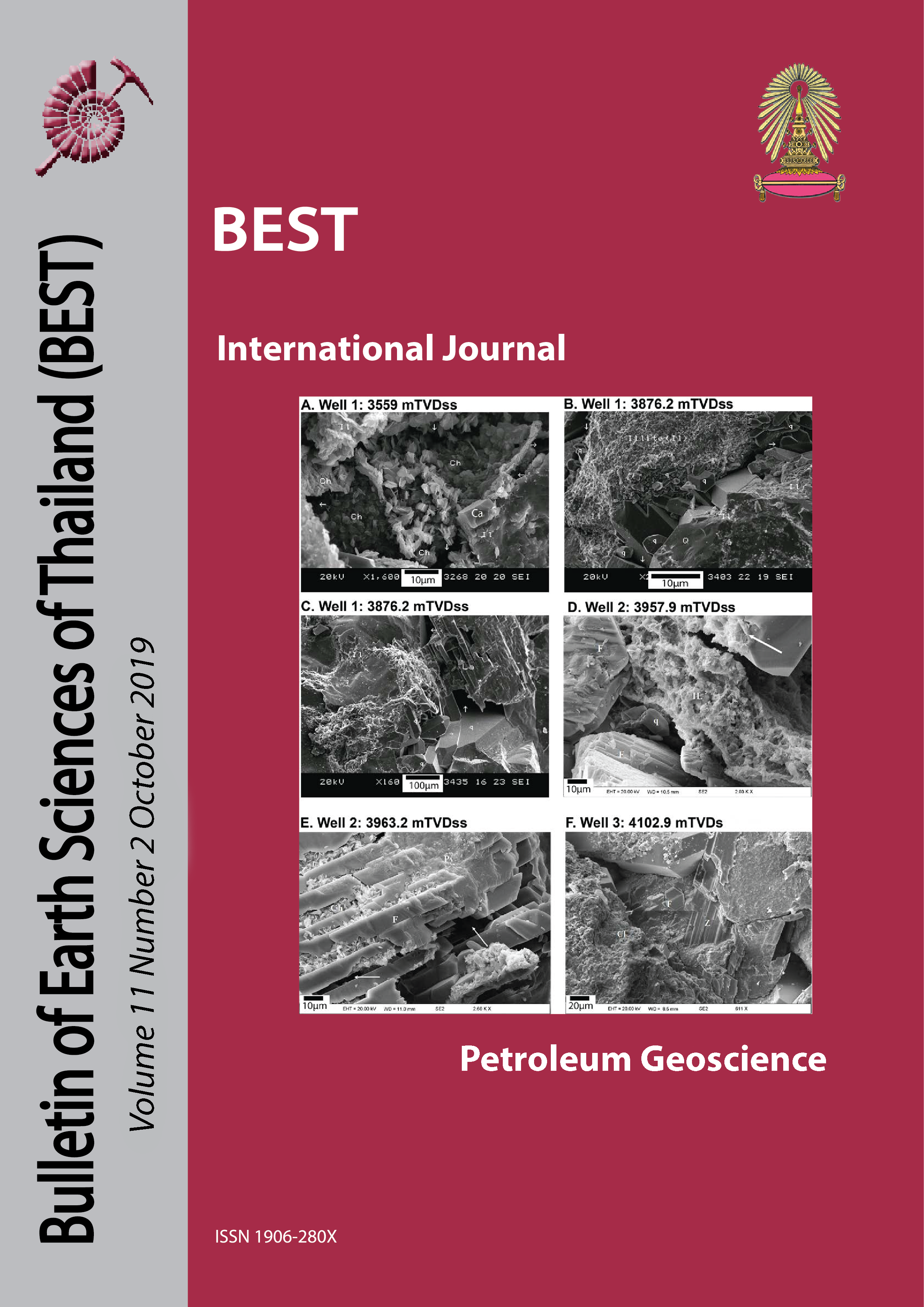Diagenetic controls on reservoir quality in the Miocene carbonate reservoir interval, offshore Myanmar
Main Article Content
Abstract
Based on long-term production from the giant Yadana gas field proving the presence of significant hydrocarbons in Miocene carbonates in the offshore of Myanmar, 10 wells were drilled Miocene carbonates in the study area in order to test the hydrocarbon potential. The study area is located some 80 to 100 kilometers from the Yadana gas field. The wells intersected a heterogeneous mix of Middle Miocene carbonates, deposited atop volcanics or volcaniclastic sediments. The wells show variable production tests in these potential reservoirs, likely responding to reservoir complexity and variable charge. A depositional model of the study area was by constructed by PTTEP in order to explain the relationship between well locations and well test performances. The result of their study suggested reservoir quality and well test performance can be related to depositionally-controlled facies belts. But this study demonstrates that not only depositional environment influences the reservoir properties, an additional, perhaps over-riding factor is diagenesis, which can be quantified across the various wells using stable isotope analysis of core and cuttings. The carbon and oxygen stable isotope determinations, which can be related to diagenetic intensity, is a new approach, not done before in the study area. And so, this study focuses on reservoir quality in the Middle Miocene carbonate, not in terms of depositional setting, but in an additional framework of diagenetic overprints and rock-fluid evolution.The isotope results suggest some sediments in the study area are in part influenced by calcite cements precipitated from circulating hydrothermal waters, moving through volcanic rocks beneath the Middle Miocene carbonate interval, and by regional burial-driven limestone recrystallization, which has significantly decreased potential reservoir quality. When results are compared to the Yadana isotope data, Yadana’s reservoir is less diagenetically evolved, and experienced shallower burial with flushing by cooler burial fluids. Accordingly, there is a less pervasive diagenetic shutdown of porosity and permeability. When the study area results are plotted against isotope signatures of other south-east Asian carbonate reservoir with similar ages, it proves that diagenesis is likely to influence reservoir quality and well performance more than the porosity distribution pattern defined in the original depositional environment.
Article Details

This work is licensed under a Creative Commons Attribution-NonCommercial-NoDerivatives 4.0 International License.
Copyright © 2008 Department of Geology, Faculty of Science, Chulalongkorn University. Parts of an article can be photocopied or reproduced without prior written permission from the author(s), but due acknowledgments should be stated or cited accordingly.
References
Anonymous, 2013, Core description report for PTTEP by GEN Labs (September 2013), 99 p.
Chakraborty, P.P., Khan, P.K., 2009. Cenozoic geodynamic evolution of the Andaman- Sumatra subduction margin: current understanding. Isl. Arc 18, 184-200.
Eberli, G. P., F. S. Anselmetti, C. Betzler, J. H. Van Konijnenburg, and D. Bernoulli, 2004, Chapter 45 10: Carbonate platform to basin transitions on seismic data and in outcrops: Great Bahama Bank and the Maiella Platform margin, Italy, in G. P. Eberli, J. L. Masaferro, and J. F. Sarg, eds., Seismic imaging of carbonate reservoirs and systems, American Association of Petroleum Geologists Memoir 81, p. 207– 250.
Khan, P.K., Chakraborty, P.P., 2005. Two-Thiangtham, phase opening of Andaman Sea: a new seismotectonic insight. Earth Planet. Sci. Lett. 229, 259-271.
Khumputorn, M., 2019, internal presentation, PTTEP (May 2019).
Laya, K. P., 2015. Diagenesis and Petrophysical Rock-Type Study Of Oligocene BeraiCarbonate Platform, Central Kalimantan: Implications For Depositional and Reservoir Models. Bulletin of Earth Sciences of Thailand, Vol. 8, No. 2, 44-52.
Lee, T.-Y., Lawver, L.A., 1995. Cenozoic plate reconstruction of Southeast Asia. Tectonophysics 251, 85-138.
Morley, C.K., 2002. A tectonic model for the Tertiary evolution of strike-slip faults and rift basins in SE Asia. Tectonophysics 347, 189-215.
Morley, C.K., 2013. Discussion of tectonic models for Cenozoic strike-slip fault affected continental margins of mainland SE Asia. J. Asian Earth Sci. 76, 137-151.
Mueller, J., 2004, Myanmar places offshore prospects in the spotlight: Offshore Engineer.
Nelson, C. S., and A. M. Smith, 1996, Stable oxygen and carbon isotope compositional fields for skeletal and diagenetic components in New Zealand Cenozoic nontropical carbonate sediments and limestones: a synthesis and review: New Zealand Journal of Geology and Geophysics, v. 39, p. 93107.
Racey, A., Ridd, M.F., 2015. Petroleum geology of the Moattama region, Myanmar. In: Racey, A., Ridd, M.F. (Eds.) Geological Society of London Memoir, vol. 45, pp. 63-81.
Thornton, S.E., 2015, The history of petroleum exploration in the union of Myanmar: AAPG-SEG ICE, Melbourne, 33 p.
Warren, J. K., 2008, Carbonate concepts and their applications in the search for shoalwater carbonate, offshore Myanmar. Internal report, PTTEP (November 2008), 44 p.


